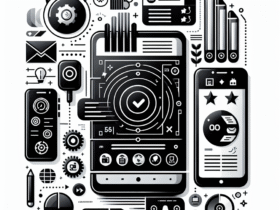Jack Dorsey’s Bitchat: Revolutionary Bluetooth Messaging App That Works Without Internet
Twitter co-founder and Block CEO Jack Dorsey has unveiled his latest innovation in decentralized communication: Bitchat, a peer-to-peer messaging application that operates entirely over Bluetooth mesh networks without requiring internet connectivity. Launched as a weekend project in July 2025, Bitchat represents Dorsey’s continued push toward decentralized, censorship-resistant communication platforms. This comprehensive review examines the revolutionary app’s features, potential applications, and the security concerns that have emerged since its debut.
Understanding Bitchat: A New Paradigm in Messaging
Core Technology and Innovation
Bitchat operates over Bluetooth Low Energy (BLE), allowing nearby devices to form a mesh network that relays messages hop-by-hop. This innovative approach eliminates the need for traditional internet infrastructure, making communication possible even in areas with poor connectivity or during internet shutdowns.
Key Technical Features:
- No internet, central servers, phone numbers or emails required
- Messages are stored only on device, disappear by default and never touch centralized infrastructure
- Extended range up to 300 meters (984 feet) through peer relaying
- End-to-end encryption for private messages
- IRC-like chat rooms with password protection
How Bluetooth Mesh Networking Works
As users move through physical space, their phones form local Bluetooth clusters and pass messages from device to device, allowing them to reach peers beyond standard range. This creates a dynamic network that expands and contracts based on user proximity and movement.
Network Architecture:
- BLE has an expected outdoor range of about 55 to 78 meters, with Dorsey’s technical paper citing a range of about 30 meters for local network clusters
- Certain “bridge” devices connect overlapping clusters, expanding the mesh across greater distances
- Automatic multi-hop message relaying enables communication beyond direct Bluetooth range
- Future versions will support Wi-Fi Direct to increase speed and network size
Features and User Experience
Chat Functionality
Bitchat functions similar to a 36-year-old messaging system called IRC (Internet Relay Chat), allowing users to converse in topic-based chat rooms or message people directly.
Communication Options:
- Group chats that can be named with hashtags and protected with passwords
- Encrypted private messaging between users
- Message forwarding to users who are temporarily offline
- No requirement for phone numbers or email addresses
- Activity tracking is completely absent
Privacy and Security Design
The network is fully decentralized with no central servers, accounts, email addresses, phone numbers to register, or infrastructure dependencies. This design philosophy aligns with Dorsey’s longstanding advocacy for user privacy and platform independence.
Privacy Features:
- Ephemeral messaging where messages exist only in device memory by default
- No accounts, no identifiers and no data collection
- No phone numbers required – just pure encrypted communication
- End-to-end encryption promises for private messages
Real-World Applications and Use Cases
Emergency and Crisis Communication
This kind of technology was used during Hong Kong’s 2019 protests to keep communication lines open, highlighting Bitchat’s potential value in crisis situations where traditional communication infrastructure may be compromised.
Crisis Communication Benefits:
- Designed to keep working even when the internet is blocked
- Censorship-resistant way to stay connected during outages, shutdowns or surveillance
- Emergency coordination when cellular networks are overloaded
- Communication in remote areas without internet infrastructure
- Disaster response scenarios where traditional networks fail
Event and Festival Communication
Because of Bluetooth’s technical limitations, this kind of app generally works at a range of around 100 meters, making it useful for situations like finding friends at a busy music festival where cell service is spotty.
Event Applications:
- Music festivals and large gatherings with poor cell coverage
- Conference networking without relying on venue WiFi
- Sporting events where cellular networks are congested
- Remote outdoor activities like hiking or camping
- Protests and demonstrations requiring secure communication
Technical Implementation and Development
Platform Availability
Dorsey opened Bitchat to beta testers via Apple’s TestFlight, but the test is now full after hitting its 10,000-user maximum. The rapid filling of beta slots demonstrates significant interest in the platform.
Current Status:
- Early build available on iOS via Apple’s TestFlight program (currently full)
- Platform-agnostic system can be baked into an Android app
- Users presently must build and install on iOS themselves, as the app has not yet been approved by Apple for App Store distribution
- Source code and whitepaper available on GitHub
Open Source Development
Dorsey has released the source code for the peer-to-peer messaging app on GitHub, enabling community contribution and transparency in development.
Development Resources:
- Complete whitepaper describing protocol available on GitHub
- Open source codebase for community review and contribution
- Technical documentation for developers interested in mesh networking
- Transparent development process following Dorsey’s decentralization philosophy
Security Concerns and Limitations
Acknowledged Security Issues
Despite Dorsey’s security claims, the app and its code have not been reviewed or tested for security issues at all — by Dorsey’s own admission. This has led to significant concerns from security researchers.
Current Security Warnings:
- Dorsey has added a warning to Bitchat’s GitHub page: “This software has not received external security review and may contain vulnerabilities”
- Jordan Mecom, an embedded software engineer at Dorsey’s company Block, has submitted a pull request asking Dorsey to add a warning message
- Security researcher Alex Radocea found that it’s possible to impersonate someone else and trick a person’s contacts
- Issues about cryptographic gaps, user impersonation concerns have been reported
Technical Vulnerabilities
Radocea found that Bitchat has a “broken identity authentication/verification” system that allows an attacker to intercept someone’s “identity key” and “peer id pair”.
Identified Issues:
- Concerns with Dorsey’s claims that Bitchat has “forward secrecy”
- Someone pointed out a potential buffer overflow bug
- Identity verification system allows potential impersonation attacks
- For true Perfect Forward Secrecy, it should use Signal-style X3DH + double ratchet, or MLS
Comparison with Existing Solutions
Similar Applications
This is fairly similar to other mesh-based messaging tools like the now-defunct FireChat and Bridgefy. However, Bitchat’s association with Dorsey and its open-source nature distinguish it from predecessors.
Competitive Landscape:
- One of the most popular Bluetooth messaging apps, Bridgefy, was notably used during pro-democracy protests in Hong Kong
- OpenGarden in 2014 released a peer-to-peer Bluetooth-based messaging app called FireChat, but the app was not secure
- Coincidentally, Bridgefy is funded in part by another Twitter co-founder, Biz Stone
- Signal and WhatsApp offer better security but require internet connectivity
Advantages Over Traditional Messaging
Unlike mainstream messaging platforms such as Meta’s WhatsApp and Messenger, which are owned and built by big tech companies and rely on personal data, Bitchat operates entirely peer-to-peer.
Key Differentiators:
- No dependence on internet infrastructure or cellular networks
- Complete elimination of centralized data collection
- Resistance to government censorship and surveillance
- Open source development enabling community oversight
- No registration requirements or personal identifiers needed
Dorsey’s Vision and Philosophy
Decentralization Advocacy
Dorsey’s newfound foray into developing Bitchat makes sense, given his long-term interests in decentralizing tech — he is a massive proponent of Bitcoin. This latest project continues his pattern of supporting technologies that reduce centralized control.
Previous Decentralization Projects:
- He originally founded the project that would become Bluesky while he was CEO of Twitter
- He also founded Damus, a completely separate decentralized social network
- The launch builds on his support of Damus and Bluesky and reflects a broader campaign to decentralize everything from social media to payments
- Long-standing advocacy for Bitcoin and blockchain technologies
Inspiration from Bitcoin
Much like Bitcoin eliminates reliance on centralized intermediaries in finance, Bitchat would remove central authorities from digital communication. This philosophical alignment demonstrates Dorsey’s consistent vision for decentralized technologies.
Bitcoin-Inspired Design:
- Dorsey describes Bitchat as a “decentralized, peer-to-peer messaging application,” evoking connections to the Bitcoin whitepaper’s intro
- Elimination of trusted third parties in communication
- Peer-to-peer network architecture similar to Bitcoin’s design
- Open source development model encouraging community participation
Challenges and Limitations
Technical Constraints
Users have to be fairly close to other users to connect to anyone. And given the technical barriers to building and installing the app, you may want to bring a friend to try it out.
Current Limitations:
- Limited range requiring physical proximity for direct communication
- Network effects dependent on user adoption and density
- Technical barriers to installation limiting mainstream adoption
- Battery consumption from constant Bluetooth mesh networking
- Platform limitations currently restricting availability to iOS beta
Adoption Challenges
Whether the idea will stick or go on as a niche project for technically inclined idealists, it’s hard to say. Mainstream adoption faces several hurdles.
Adoption Barriers:
- Need for critical mass of users in physical proximity
- Technical complexity may deter average consumers
- Security concerns until thorough auditing is completed
- Competition from established messaging platforms
- Limited utility without widespread adoption
Future Development and Roadmap
Planned Enhancements
A future version of the app will support Wi-Fi Direct to increase the speed and size of the network, potentially addressing some current range and performance limitations.
Development Priorities:
- Wi-Fi Direct integration for expanded range and speed
- Security auditing and vulnerability remediation
- Android platform development and release
- Improved user interface and experience design
- Enhanced encryption and identity verification systems
Learning Project Status
Dorsey described it as “my weekend project to learn about bluetooth mesh networks, relays and store and forward models, message encryption models, and a few other things”. This experimental nature suggests the project may evolve significantly.
Project Evolution:
- At present, Bitchat appears to mostly be an experiment and a learning project for Dorsey
- Open source development enabling community contributions
- Potential for enterprise or specialized applications
- Integration with other decentralized technologies
- Commercial applications in secure communication markets
Market Implications and Industry Impact
Influence on Messaging Industry
Bitchat’s introduction highlights growing interest in alternative communication methods that prioritize privacy and censorship resistance over convenience and features.
Industry Trends:
- Increased focus on decentralized communication protocols
- Growing concern about big tech data collection practices
- Rising demand for censorship-resistant communication tools
- Innovation in mesh networking and peer-to-peer technologies
- Integration of blockchain concepts into communication platforms
Potential Applications Beyond Personal Messaging
The underlying technology could have applications beyond casual messaging, particularly in enterprise and emergency response scenarios.
Commercial Applications:
- Emergency response and disaster communication systems
- Corporate communications in high-security environments
- Military and defense applications requiring secure mesh networks
- IoT device communication in industrial settings
- Rural and remote area communication infrastructure
Expert Opinions and Industry Reaction
Security Community Response
Security researcher Alex Radocea warned that Bitchat users should not trust the app yet, noting “There are people out there that would take the messaging around security literally and could rely on it for their safety”.
Expert Concerns:
- “Security is a great feature to have for going viral. But a basic sanity check, like, do the identity keys actually do any cryptography, would be a very obvious thing to test”
- Premature security claims could endanger users in high-risk situations
- Need for thorough third-party security auditing before widespread adoption
- Importance of realistic expectations about experimental software
Technology Community Interest
Dorsey’s post on X has received over 1.3 million views, with beta testers eager to jump in, demonstrating significant interest in the technology despite its experimental status.
Community Response:
- Rapid filling of 10,000 TestFlight beta slots
- Active discussion on social media and technology forums
- Developer interest in mesh networking technologies
- Academic interest in decentralized communication research
- Privacy advocate enthusiasm for censorship-resistant tools
Conclusion: A Bold Experiment in Decentralized Communication
Jack Dorsey’s Bitchat represents an ambitious attempt to reimagine messaging through decentralized, internet-free communication. While the app currently faces significant security concerns and technical limitations, its innovative approach to mesh networking and commitment to user privacy align with growing demands for alternatives to centralized big tech platforms.
The project’s experimental nature and Dorsey’s track record of supporting transformative technologies suggest that Bitchat could evolve into something much more significant than a weekend coding project. However, realizing this potential will require addressing fundamental security issues, expanding platform availability, and building the critical mass of users necessary for mesh networking to be effective.
For users considering Bitchat, the current recommendation is to view it as an interesting experiment rather than a reliable communication tool. The security warnings from both Dorsey and independent researchers underscore the need for caution, particularly for users who might depend on secure communication for their safety or privacy.
Ultimately, Bitchat’s significance may lie not in its current implementation but in its demonstration of alternative approaches to digital communication. As concerns about platform censorship, data privacy, and internet infrastructure vulnerability continue to grow, projects like Bitchat offer valuable insights into possible futures for human communication technology.
Whether Bitchat becomes a mainstream messaging solution or remains a niche tool for specific use cases, it represents an important step in the ongoing evolution toward more decentralized, user-controlled communication systems that could reshape how we think about digital connectivity and privacy in the modern world.






Leave a Reply